 AD
AD
Today is: November 06
Scroll to explore events active on this date.
LEEP INK FEATURES

August is Appropos
A toddler playing in the fountain at a park in Santa Fe, New Mexico—Photo LD Lewis. In August, we live through the Dog Days of Summer. It's hot and often humid, and those ...

September is Sassy
Can you hear that sigh of relief from parents worldwide? Yes! September marks the return of students to school, a global phenomenon. Preparations for the ACT and SATs begin earnestly for ...

OOH LA LA, October
October is the busiest month for events, with 5% more happening than in May, the second most eventful month. Sailing enthusiasts will be glued to the finals of this year's Am...
About 2025, the Year of Caladium
Real Estate
Ends: Dec 31, 2025
DESCRIPTION:
THE PICASO OF PLANTS:
2025 IS THE YEAR OF CALADIUM
The National Garden Bureau has designated 2025 the Year of Caladium, celebrating plants with vibrant and decorative foliage in the genus Caladium. This recognition aims to highlight these plants' beauty and versatility, encouraging their cultivation and appreciation in gardens and landscapes worldwide.
Caladiums are tuberous tropical plants known for their stunning, colorful leaves, which come in various shapes and patterns. These leaves can display combinations of green, white, red, pink, and other hues, often with striking veining and variegation. Caladiums belong to the Araceae family and are commonly grown for their ornamental value rather than for their flowers.IDEAL GROWING CONDITIONS
Caladiums are native to South and Central America, particularly Brazil and surrounding regions. They thrive in warm, humid climates, typically in tropical forests. For optimal growth, caladiums require:
—Shade or Partial Sun:
While they tolerate some sun, too much direct sunlight can scorch their delicate leaves. Dappled shade or filtered light is ideal.
—Well-Drained Soil:
Caladiums prefer rich, well-draining soil that retains moisture without becoming waterlogged.
—Warm Temperatures:
These plants grow best in temperatures ranging from 70°F to 85°F (21°C to 29°C). They are sensitive to cold and should be protected from temperatures below 60°F (15°C).
NOT A MEDICINAL PLANT
Unlike some other plants, caladiums are not widely known for their medicinal properties. They contain calcium oxalate crystals, which can be toxic if ingested, causing irritation and swelling of the mouth and throat. Therefore, caladiums are valued for their aesthetic qualities rather than medicinal use.POPULARITY AND USES
Caladiums are popular for several reasons:
—Aesthetic Appeal:
Caladiums' primary popularity is their vibrant, colorful foliage. Their lush, decorative leaves can brighten up shady garden areas, containers, and indoor spaces.
—Variety:
Numerous cultivars offer various colors and patterns to suit different tastes and design needs.
—Versatility:
Caladiums are versatile plants that can be used in various settings, including garden beds, borders, hanging baskets, and houseplants. Their adaptability makes them a favorite among gardeners and landscape designers.
Caladiums are relatively easy to grow and maintain with the right conditions. Their ability to thrive in shady areas makes them a practical choice for gardens with limited sunlight.
The Year of Caladium aims to celebrate and promote the beauty and versatility of these plants. This designation encourages horticultural societies, botanical gardens, and gardening enthusiasts to explore the diverse range of caladiums, share growing tips, and participate in events and activities that showcase their ornamental value.
VIDEOS
SUPPORTING DOCUMENTS
Currently, this event does not have supporting documents.
ADDITIONAL IMAGES
Currently, this event does not have supporting images.
Where would you like to go now?
 AD
AD


/footer-logo.svg)
